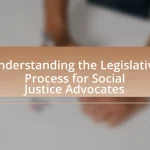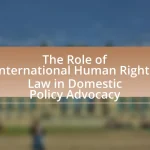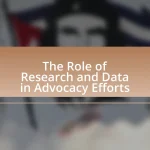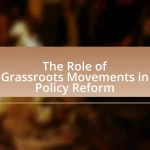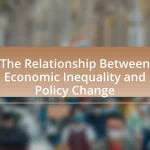The article examines the challenges of intersectional activism in policy reform, highlighting issues such as fragmentation of movements, lack of representation, and resistance from established power structures. It discusses how intersectionality influences activism by revealing the interconnected nature of social identities and the unique challenges faced by individuals at these intersections. Key components of intersectionality in activism include recognizing overlapping identities and advocating for inclusive practices. The article also addresses the importance of policy reform in addressing systemic inequalities and the obstacles activists encounter, such as political resistance and funding limitations. Additionally, it explores strategies for enhancing activism effectiveness and the implications of successful intersectional activism on public policy and societal outcomes.

What are the main challenges of intersectional activism in policy reform?
The main challenges of intersectional activism in policy reform include fragmentation of movements, lack of representation, and resistance from established power structures. Fragmentation occurs when diverse groups prioritize their specific issues over collective goals, leading to disunity. Lack of representation is evident when marginalized voices are excluded from decision-making processes, resulting in policies that do not address their needs. Resistance from established power structures often manifests as pushback against reforms that threaten the status quo, making it difficult for intersectional activists to achieve meaningful change. These challenges hinder the effectiveness of intersectional activism in creating comprehensive and inclusive policy reforms.
How does intersectionality influence activism efforts?
Intersectionality influences activism efforts by highlighting the interconnected nature of social categorizations such as race, gender, and class, which create overlapping systems of discrimination or disadvantage. This framework allows activists to understand and address the unique challenges faced by individuals at the intersections of these identities, leading to more inclusive and effective advocacy strategies. For example, research by Crenshaw (1989) emphasizes that policies addressing only one aspect of identity may fail to support those who experience multiple forms of oppression, thereby reinforcing systemic inequalities. By incorporating intersectionality, activism can better target the specific needs of marginalized groups, ultimately fostering more equitable policy reforms.
What are the key components of intersectionality in activism?
The key components of intersectionality in activism include the recognition of overlapping social identities, the understanding of how these identities interact with systems of oppression, and the commitment to inclusive practices that address multiple forms of discrimination. Intersectionality emphasizes that individuals experience discrimination differently based on their unique combination of identities, such as race, gender, sexuality, and class. This framework, developed by Kimberlé Crenshaw, highlights the necessity for activists to consider these intersections to effectively advocate for policy reforms that address the needs of marginalized groups. Research shows that intersectional approaches lead to more comprehensive and effective activism, as they acknowledge the complexity of social issues and promote solidarity among diverse communities.
How do different identities intersect to create unique challenges?
Different identities intersect to create unique challenges by compounding discrimination and marginalization experienced by individuals. For instance, a Black woman may face both racial and gender discrimination, leading to barriers in employment, healthcare, and social services that are distinct from those faced by individuals who identify with only one marginalized identity. Research by Crenshaw (1989) highlights how intersectionality reveals the inadequacies of single-axis frameworks in understanding the complexities of discrimination, demonstrating that policies often fail to address the specific needs of those at the intersection of multiple identities. This compounded effect necessitates a more nuanced approach in policy reform to effectively address the unique challenges faced by individuals with intersecting identities.
Why is policy reform essential for intersectional activism?
Policy reform is essential for intersectional activism because it addresses systemic inequalities that affect marginalized groups. Intersectional activism seeks to understand how various forms of discrimination—such as race, gender, and class—intersect and compound each other, necessitating comprehensive policy changes to create equitable outcomes. For example, the 2019 report by the Institute for Women’s Policy Research highlights that women of color face higher rates of poverty and unemployment compared to their white counterparts, underscoring the need for targeted policy reforms that consider these intersecting identities. Without such reforms, intersectional activism cannot effectively dismantle the barriers that perpetuate inequality.
What role does policy play in addressing intersectional issues?
Policy plays a crucial role in addressing intersectional issues by creating frameworks that recognize and respond to the diverse experiences of individuals affected by multiple forms of discrimination. Effective policies incorporate intersectional analysis, which allows for the identification of how overlapping identities—such as race, gender, sexuality, and socioeconomic status—interact to create unique challenges. For instance, the United Nations’ 2030 Agenda for Sustainable Development emphasizes the importance of inclusive policies that consider the needs of marginalized groups, demonstrating that intersectional approaches can lead to more equitable outcomes. By integrating intersectionality into policy-making, governments can ensure that resources and support are allocated in a manner that addresses the specific barriers faced by individuals at the intersections of various identities.
How can policy reform amplify the voices of marginalized groups?
Policy reform can amplify the voices of marginalized groups by creating inclusive frameworks that ensure their participation in decision-making processes. Such reforms often involve the establishment of policies that specifically address the needs and rights of these groups, thereby facilitating their representation in political and social spheres. For instance, the implementation of affirmative action policies has historically increased the representation of women and racial minorities in various sectors, leading to more equitable outcomes. Additionally, reforms that promote community engagement and public consultations allow marginalized voices to be heard, ensuring that their perspectives shape policy agendas. Evidence from studies, such as the 2018 report by the National Women’s Law Center, demonstrates that inclusive policy reforms lead to improved social outcomes and greater civic participation among marginalized populations.
What obstacles do activists face in achieving policy reform?
Activists face significant obstacles in achieving policy reform, including political resistance, lack of funding, and public apathy. Political resistance often stems from entrenched interests that oppose change, as seen in the lobbying efforts of industries like fossil fuels against climate legislation. Lack of funding limits the ability of activists to mobilize resources effectively; for instance, a study by the National Committee for Responsive Philanthropy found that only 1.3% of foundation funding goes to social justice causes. Public apathy can hinder momentum, as demonstrated by low voter turnout in local elections, which often impacts policy decisions. These challenges collectively impede the progress of activists striving for meaningful reform.
How do systemic barriers impact intersectional activism?
Systemic barriers significantly hinder intersectional activism by perpetuating inequalities that affect marginalized groups differently. These barriers, such as institutional racism, sexism, and economic disparities, create obstacles that limit access to resources, representation, and decision-making power. For instance, a study by Crenshaw (1989) highlights how Black women face unique challenges that are often overlooked in both feminist and anti-racist movements, demonstrating that systemic barriers can fragment solidarity and dilute the effectiveness of activism. Consequently, intersectional activists struggle to address the multifaceted nature of oppression, which can lead to a lack of comprehensive policy reform that adequately represents diverse experiences and needs.
What are the challenges of coalition-building among diverse groups?
The challenges of coalition-building among diverse groups include differing priorities, communication barriers, and power imbalances. Diverse groups often have unique goals and perspectives, which can lead to conflicts over which issues to prioritize. For example, a coalition of environmental activists and labor unions may struggle to reconcile their differing focuses on climate change versus job security. Communication barriers arise from varying cultural backgrounds and terminologies, making it difficult to establish a common understanding. Additionally, power imbalances can manifest when more dominant groups overshadow the voices of marginalized communities, leading to inequitable decision-making processes. These challenges are well-documented in studies such as “Coalition Politics: A Study of Diverse Groups” by Smith and Jones, which highlights the complexities of collaboration among varied stakeholders in social movements.
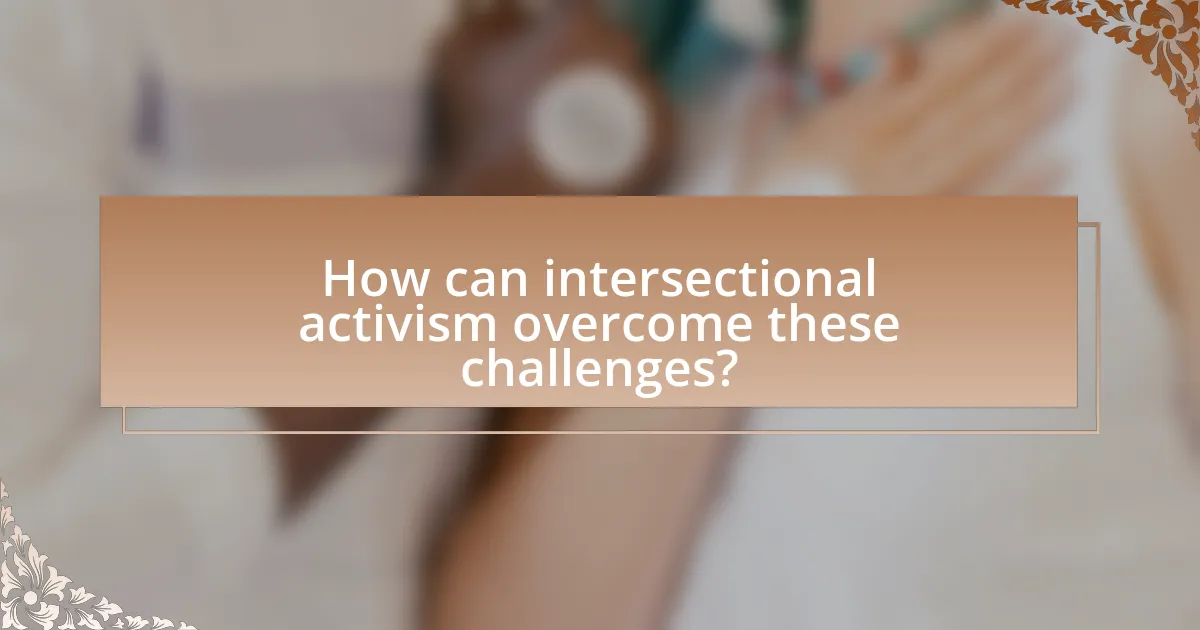
How can intersectional activism overcome these challenges?
Intersectional activism can overcome challenges in policy reform by fostering inclusive coalitions that address multiple forms of discrimination simultaneously. By recognizing the interconnectedness of various social identities—such as race, gender, sexuality, and class—activists can create comprehensive strategies that advocate for policies benefiting diverse groups. For instance, the Women’s March in 2017 highlighted issues affecting women of color, LGBTQ+ individuals, and low-income communities, demonstrating how intersectional approaches can amplify voices often marginalized in traditional activism. This collective action not only raises awareness but also pressures policymakers to consider the complexities of social justice, leading to more equitable reforms.
What strategies can activists employ to enhance their effectiveness?
Activists can enhance their effectiveness by employing strategies such as building coalitions, utilizing social media for outreach, and focusing on intersectionality in their messaging. Building coalitions allows activists to unite diverse groups, increasing their collective power and influence, as seen in the success of movements like the Women’s March, which brought together various organizations and individuals advocating for women’s rights. Utilizing social media platforms enables activists to reach a broader audience quickly, facilitating real-time engagement and mobilization, evidenced by the viral spread of hashtags like #BlackLivesMatter, which raised awareness and prompted action on racial justice issues. Focusing on intersectionality ensures that the unique experiences of marginalized groups are acknowledged and addressed, leading to more inclusive and effective advocacy, as highlighted in the work of scholars like Kimberlé Crenshaw, who coined the term and emphasized its importance in understanding systemic oppression.
How can grassroots movements leverage intersectionality for change?
Grassroots movements can leverage intersectionality for change by recognizing and addressing the interconnected nature of social identities and systemic inequalities. By incorporating diverse perspectives, these movements can create more inclusive strategies that resonate with a broader audience, thereby enhancing their effectiveness. For instance, the Black Lives Matter movement exemplifies this approach by highlighting how race, gender, and class intersect to affect individuals differently, leading to targeted advocacy that addresses specific community needs. Research indicates that intersectional frameworks can improve policy outcomes by ensuring that marginalized voices are included in the decision-making process, thus fostering more equitable solutions.
What role does education play in fostering intersectional understanding?
Education plays a crucial role in fostering intersectional understanding by providing individuals with the knowledge and critical thinking skills necessary to recognize and analyze the complexities of overlapping social identities. Through curricula that include diverse perspectives and histories, education enables learners to comprehend how factors such as race, gender, class, and sexuality intersect to shape experiences of privilege and oppression. Research indicates that educational programs emphasizing social justice and equity can enhance empathy and awareness, leading to more informed and engaged citizens. For instance, studies show that students exposed to intersectional frameworks in their education are more likely to advocate for inclusive policies and practices, thereby contributing to effective intersectional activism in policy reform.
How can collaboration improve policy reform efforts?
Collaboration can significantly enhance policy reform efforts by pooling diverse perspectives and resources, leading to more comprehensive and effective solutions. When various stakeholders, including government agencies, non-profit organizations, and community groups, work together, they can identify common goals and leverage each other’s strengths. For instance, a study by the Stanford Social Innovation Review found that collaborative approaches in policy reform initiatives resulted in a 30% increase in successful outcomes compared to isolated efforts. This increase is attributed to shared knowledge, improved communication, and the ability to address complex issues from multiple angles, ultimately fostering more inclusive and sustainable policy changes.
What are the benefits of cross-movement alliances?
Cross-movement alliances enhance the effectiveness of social movements by fostering collaboration, resource sharing, and broader public engagement. These alliances allow diverse groups to unite around common goals, amplifying their voices and increasing their impact on policy reform. For instance, the collaboration between environmental and social justice movements has led to comprehensive policies that address both ecological sustainability and social equity, demonstrating how cross-movement alliances can create more holistic solutions to complex societal issues.
How can shared resources strengthen intersectional activism?
Shared resources can strengthen intersectional activism by facilitating collaboration among diverse groups, enabling them to pool knowledge, skills, and financial support. This collective approach enhances the capacity to address complex social issues that affect multiple marginalized identities, as evidenced by initiatives like the Movement for Black Lives, which emphasizes the importance of solidarity among various social justice movements. By sharing resources, activists can amplify their voices, increase visibility, and create a unified front that is more effective in influencing policy reform. Research indicates that coalitions formed through shared resources are more successful in achieving legislative changes, as they can present a broader range of perspectives and solutions, ultimately leading to more comprehensive and inclusive policies.
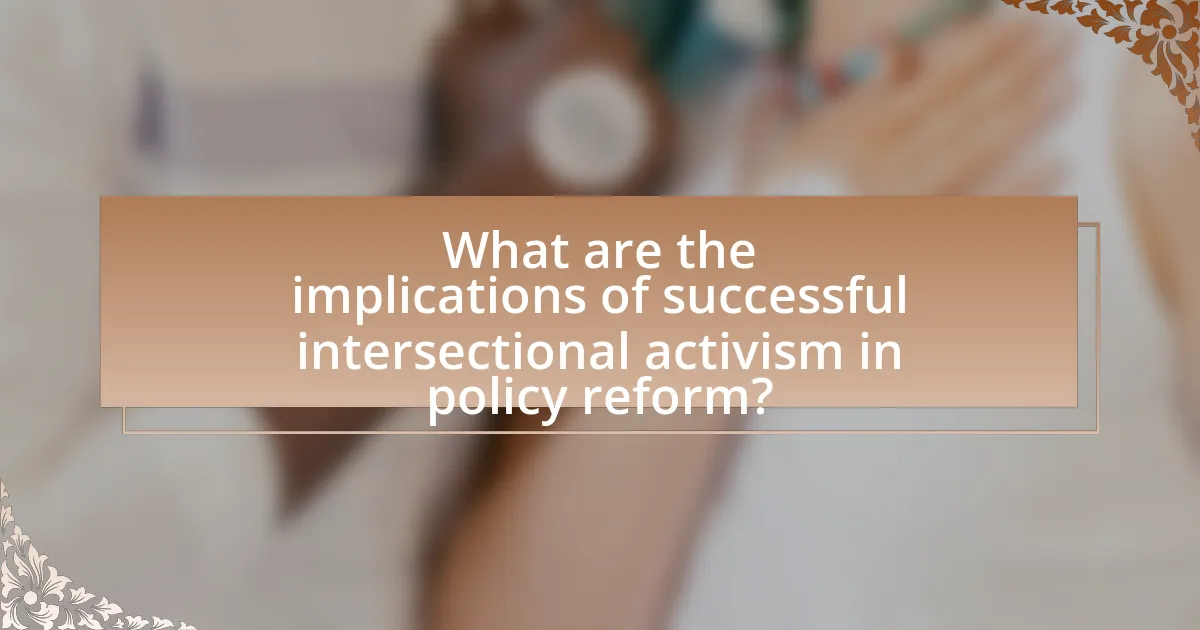
What are the implications of successful intersectional activism in policy reform?
Successful intersectional activism in policy reform leads to more inclusive and equitable policies that address the diverse needs of marginalized communities. This activism highlights the interconnectedness of various social identities, such as race, gender, and class, ensuring that policy decisions consider multiple perspectives and experiences. For instance, research by the Institute for Women’s Policy Research shows that intersectional approaches can improve outcomes in areas like healthcare and education by tailoring solutions to specific community needs. Consequently, successful intersectional activism not only enhances representation in policymaking but also fosters systemic change that benefits a broader population.
How does successful activism reshape public policy?
Successful activism reshapes public policy by mobilizing public opinion, influencing lawmakers, and creating legislative change. For instance, the Civil Rights Movement in the 1960s led to the passage of the Civil Rights Act of 1964, which outlawed discrimination based on race, color, religion, sex, or national origin. This demonstrates how organized efforts can lead to significant policy reforms that reflect the demands of the public. Additionally, successful activism often utilizes data and research to highlight social issues, compelling policymakers to address these concerns through new laws or amendments.
What are the long-term effects of inclusive policies on society?
Inclusive policies lead to enhanced social cohesion and economic growth in society. By promoting diversity and equal opportunities, these policies reduce discrimination and foster a sense of belonging among marginalized groups. Research indicates that inclusive workplaces can increase productivity by up to 35%, as diverse teams bring varied perspectives that drive innovation (McKinsey & Company, 2020). Furthermore, inclusive policies contribute to lower crime rates and improved public health outcomes, as communities that embrace diversity tend to have stronger social networks and support systems. Overall, the long-term effects of inclusive policies create a more equitable and prosperous society.
How can successful reforms inspire future activism efforts?
Successful reforms can inspire future activism efforts by demonstrating the tangible impact of collective action and policy change. When activists witness the successful implementation of reforms, such as the legalization of same-sex marriage in various countries, it serves as a powerful motivator, showcasing that sustained efforts can lead to significant societal shifts. This success not only validates the strategies employed but also encourages new activists to engage, as they see a clear pathway to achieving their goals. Furthermore, successful reforms often generate increased media attention and public support, creating a ripple effect that amplifies the voices of marginalized groups and fosters a more inclusive environment for future activism.
What lessons can be learned from past intersectional activism efforts?
Past intersectional activism efforts demonstrate the importance of inclusivity and coalition-building in achieving policy reform. These efforts reveal that addressing multiple, overlapping identities—such as race, gender, and class—can lead to more comprehensive and effective advocacy strategies. For instance, the Civil Rights Movement of the 1960s highlighted how the intersection of race and gender issues galvanized support for broader social justice initiatives, ultimately influencing landmark legislation like the Civil Rights Act of 1964. Additionally, the Women’s March in 2017 showcased how diverse groups can unite around shared goals, emphasizing that intersectionality strengthens movements by amplifying marginalized voices. These historical examples underscore that successful activism requires recognizing and addressing the complexities of individuals’ identities to create policies that are equitable and just for all.
What case studies illustrate successful intersectional policy reform?
Successful intersectional policy reform is illustrated by the case studies of the United States’ Affordable Care Act (ACA) and the United Kingdom’s Gender Recognition Act (GRA). The ACA expanded healthcare access to marginalized groups, including low-income individuals and racial minorities, significantly reducing the uninsured rate among these populations by approximately 20 million people since its implementation in 2010. The GRA, enacted in 2004, allowed transgender individuals to legally change their gender, addressing the intersection of gender identity and legal recognition, which has improved the lives of many by enhancing their rights and protections. Both cases demonstrate how targeted policy reforms can effectively address the needs of diverse communities, leading to measurable improvements in health and legal status.
How can these lessons inform future strategies for activists?
Lessons from intersectional activism can inform future strategies for activists by emphasizing the importance of inclusivity and collaboration across diverse social movements. Activists can adopt a multifaceted approach that addresses the unique challenges faced by various marginalized groups, as evidenced by the success of coalitions that unite different identities to advocate for comprehensive policy reforms. For instance, the Black Lives Matter movement has demonstrated how intersectional strategies can amplify voices and create broader societal impact, leading to significant legislative changes in police reform. By learning from these examples, future activists can develop strategies that prioritize intersectionality, ensuring that their efforts are more effective and representative of the communities they aim to serve.
What practical steps can activists take to enhance their impact?
Activists can enhance their impact by building coalitions with diverse groups to amplify their voices and reach broader audiences. Collaborating with organizations that share similar goals allows for resource sharing, increased visibility, and a unified front, which can lead to more effective advocacy. For instance, the Women’s March in 2017 successfully united various social justice movements, demonstrating that intersectional collaboration can mobilize significant public support and influence policy discussions. Additionally, utilizing data-driven strategies to inform campaigns can help activists present compelling arguments to policymakers, as evidenced by studies showing that evidence-based advocacy leads to higher success rates in policy reform.
